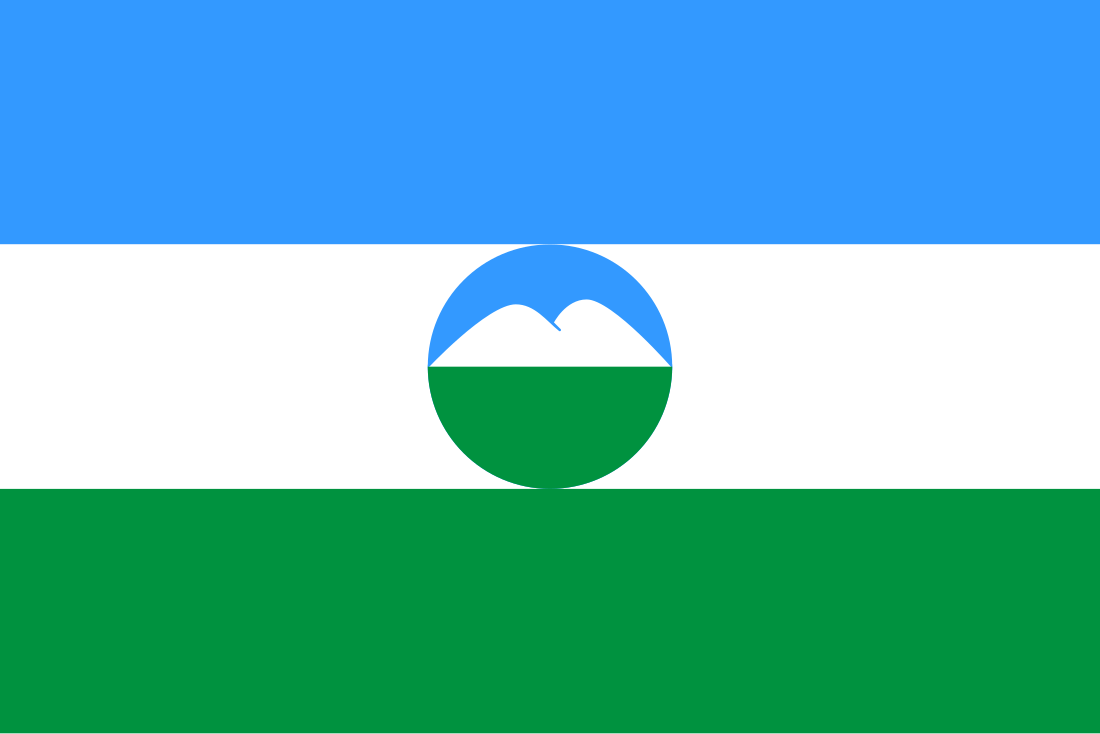Top Qs
Timeline
Chat
Perspective
Kabardino-Balkaria
Republic of Russia in the North Caucasus From Wikipedia, the free encyclopedia
Remove ads
Kabardino-Balkaria (Russian: Кабарди́но-Балка́рия), officially the Kabardino-Balkarian Republic,[note 1][10][11][12] is a republic of Russia located in the North Caucasus. As of the 2021 Census, its population was 904,200.[13] Its capital is Nalchik. The area contains the highest mountain in Europe, Mount Elbrus, at 5,642 m (18,510 ft). Mount Elbrus has 22 glaciers that feed three rivers — Baksan, Malka and Kuban. The mountain is covered with snow year-round.
Remove ads
Remove ads
Geography
Summarize
Perspective
The republic is situated in the North Caucasus mountains, with plains in the northern part. The republic shares an international border with Georgia.
- Area: 12,500 square kilometers (4,800 sq mi)
- Borders:
- internal: Stavropol Krai (N/NE), North Ossetia–Alania (E/SE/S), Karachay–Cherkessia (W/NW)
- international: Georgia (Racha-Lechkhumi and Kvemo Svaneti, Zemo Svaneti) (S/SW)
- Highest point: Mount Elbrus (5,642 m)
- Maximum N->S distance: 167 kilometers (104 mi)
- Maximum E->W distance: 123 kilometers (76 mi)
Kabardino-Balkaria is traversed by the northeasterly line of equal latitude and longitude.
Rivers
Major rivers include:
- Terek River (623 km)
- Malka River (216 km)
- Baksan River (173 km)
- Urukh River (104 km)
- Chegem River (102 km)
- Cherek River (76 km)
- Argudan River
- Kurkuzhin River
- Lesken River
Lakes
There are about 100 lakes in the Republic, none of which is large. Just over half (55) are located between the Baksan and Malka Rivers, the largest each of an area of no more than 0.01 square kilometers (0.0039 sq mi). Some of the lakes are:
- Tserikkel Lake (area 26,000 m2; depth 368 m)
- Lower Goluboye Lake
- Kel-Ketchen Lake (depth 177 m)
- Upper Tserikkel Lake (depth 18 m)
- Sekretnoye Lake
- Tambukan Lake (area 1.77 km2; depth 1.5 to 2 m), partially within Stavropol Krai.
Mountains
- Mount Elbrus (5,642 m), a volcanic mountain and the highest peak in Europe, Russia, and the Caucasus
Other major mountains include:
- Mount Dykhtau (5,402 m)
- Mount Koshtantau (5,151 m)
- Mount Shkhara (5,068 m)
- Pushkin Peak (5,033 m)
- Mount Mizhergi (5,025 m)
Natural resources
This section needs expansion. You can help by adding to it. (March 2022) |
Kabardino-Balkaria's natural resources include molybdenum, tungsten, and coal.
Climate
The republic has a continental-type climate.
- Average January temperature: −12 °C (10 °F) (mountains) to −4 °C (25 °F) (plains)
- Average July temperature: +4 °C (39 °F) (mountains) to +23 °C (73 °F) (plains)
- Average annual precipitation: 500–2,000 mm.
Remove ads
History
This section needs expansion. You can help by adding to it. (March 2022) |
It is known that modern-day Circassians also called Kassogs were inhabiting Kabardino Balkaria since at least the 6th century BC, then known as Zichia.[14] On 1 July 1994 Kabardino-Balkaria became the second republic after Tatarstan to sign a power-sharing agreement with the federal government, granting it autonomy.[15]
Remove ads
Politics
The head of government in Kabardino-Balkaria is the Head. The current Head is Kazbek Kokov.[16] The legislative body of the Republic is the Parliament comprising 72 deputies elected for a five-year term.[3][17]
The republic adopted a new constitution in 2001 which prevents the republic from existing independently of the Russian Federation.[18]
Administrative divisions
- Cities and towns under republic's jurisdiction
- Nalchik (Нальчик) (capital)
- Baksan (Баксан)
- Prokhladny (Прохладный)
- Districts:
- Baksansky (Баксанский)
- Chegemsky (Чегемский)
- Towns under the district's jurisdiction:
- Chegem (Чегем)
- Towns under the district's jurisdiction:
- Chereksky (Черекский)
- Elbrussky (Эльбрусский)
- Towns under the district's jurisdiction:
- Tyrnyauz (Тырныауз)
- Towns under the district's jurisdiction:
- Leskensky (Лескенский)
- Maysky (Майский)
- Towns under the district's jurisdiction:
- Maysky (Майский)
- Towns under the district's jurisdiction:
- Prokhladnensky (Прохладненский)
- Tersky (Терский)
- Towns under the district's jurisdiction:
- Terek (Терек)
- Towns under the district's jurisdiction:
- Urvansky (Урванский)
- Towns under the district's jurisdiction:
- Nartkala (Нарткала)
- Towns under the district's jurisdiction:
- Zolsky (Зольский)

- Cherek-Balkarskaya gorge
- Prielbrusye
- Tyzyl Gorge
Remove ads
Demographics
Summarize
Perspective
Population: 904,200 (2021 Census);[13] 859,939 (2010 Census);[20] 901,494 (2002 Census);[21] 759,586 (1989 Soviet census).[22]

| 2019 | 2021 | |
|---|---|---|
| Average: | 76.5 years | 73.8 years |
| Male: | 72.6 years | 69.9 years |
| Female: | 79.9 years | 77.3 years |
Vital statistics
Note: TFR 2009, 2010, 2011, 2012 source.[27]
Ethnic groups
Kabardino-Balkaria includes two major ethnic communities, the Kabardins (Circassians), who speak a North-West Caucasian language, and the Balkars who speak a Turkic language. According to the 2021 Census,[28] Kabardins make up 57.1% of the republic's population, followed by Russians (19.8%) and Balkars (13.7%). Other groups include Cherkess (3.0%), Turks (1.9%), Ossetians (0.8%), Romani (0.5%), and a host of smaller groups, each accounting for less than 0.5% of the total population.
- Mosque in Kabardino-Balkaria
- Catholic church in Kabardino-Balkaria (Diocese of Saratov, Blagoveshchenka)
- Balkars in 1936
- Kabardian wrestler Beslan Mudranov won Russia's first gold medal at the Rio 2016 Olympics
Religion
According to a 2012 survey which interviewed 56,900 people,[31] 70.8% of the population of Kabardino-Balkaria adhered to Islam, 11.6% to the Russian Orthodox Church, 3.8% were non-Orthodox Christians, and 1.8% followed Adyghe (Kabardian) folk religion and other indigenous faiths. In addition, 12% of the population declared to be "spiritual but not religious" and 5.6% was atheist or followed other religions, including Jehovah's Witnesses.[31]
Remove ads
See also
Notes
- Russian: Кабарди́но-Балка́рская Респу́блика, romanized: Kabardino-Balkarskaya Respublika; Kabardian: Къэбэрдей-Балъкъэр Республикэ, romanized: Ķêbêrdej-Baĺķêr Respublikê; Karachay-Balkar: Къабарты-Малкъар Республика, romanized: Qabartı-Malqar Respublika
References
Sources
External links
Wikiwand - on
Seamless Wikipedia browsing. On steroids.
Remove ads













